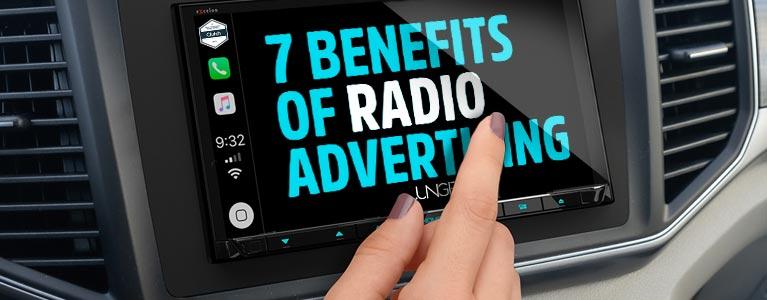Looking back on my career, I realize my journey to starting my own advertising and marketing agency and building a business that provides a genuine sense of accomplishment, began with my passion for radio.
Today, Jungle Communications is recognized as one of 2021’s Top Advertising Agencies, ranking #1 in radio advertising in New Jersey, according to Clutch.co.
The Relevance of Radio Advertising
In our digitally-driven lives, radio advertising might seem like an outdated medium. However, there’s lots of evidence to the contrary. Radio still holds a great deal of potential for brands.
Among other things, a well-executed radio advertisement campaign can increase awareness and convey your brand personality like no other medium.
It can build customer loyalty and promote your products and services at a lower cost than other forms of advertising. So, here are seven compelling reasons radio advertising remains relevant today.
1. Radio Has Tremendous Reach
More people listen to the radio during a typical month in the US than use websites and apps dedicated to online search, social media, video, and e-commerce.
“The fact of the matter is, as consumers, our eyeballs are maxed out. There are virtually no open spaces left to bolt a video screen or paste yet another logo. As the media landscape continues to fragment and evolve, a new trend is emerging: audio-based content is hip and decidedly in fashion.” — Brad Kelly, managing director of Nielsen Audio
2. Radio Enables Selective Targeting
Radio advertising allows messages to be tailored and localized to each targeted audience. Advertisers can direct their message to specific demographics, psychographics, geographic areas, and around events and genres in a market.
Radio advertisements are tailored to particular times of day to ensure you’re reaching your desired audience at precisely the right time.
Each radio station’s genre caters to a particular niche or market segment. After careful evaluation and execution, your exact target market will hear your advertisement. Whether you want to attract teens or engage families, radio ads can broadcast your message directly to them.
There are over 25,000 on-air radio personalities across the country. These personalities are also referred to as talent, DJs, jocks, influencers, experts, journalists, real people, and friends by their loyal listeners.
They are one-to-many, person-to-person influencers who help inspire trust and loyalty and drive conversation.
Not only do 56% of listeners state that radio talent is the main reason they tune in, but 37% of music listeners say that one of the things they like most about listening to traditional radio – that adds to their enjoyment of the music – are the DJs.
According to a Katz Media Group survey of radio listeners:
- 87% are privy to details of the DJ’s personal life.
- 5 out of 10 follow a DJ or radio station on social media.
- 4 out of 10 have met a DJ personally in their community.
- 8 out of 10 say they would consider trying something that their favorite radio personality endorses.
3. Radio Is Cost-Effective
Radio advertising can improve your campaign’s cost-effectiveness. The reason for this is information transmitted through sound is more memorable, which, in turn, helps increase your brand’s “share of mind.”
Furthermore, a joint study by Nielsen and Catalina Solutions found that a product advertised on radio in the consumer-packaged-goods realm delivered $12 in sales for every $1 spent on advertising.
Additionally, radio advertisements is less expensive and faster to produce than typical lead times required by TV and print if revisions are necessary. Couple that with its reach and frequency, and radio ranks as a top choice.
4. Radio Improves Brand Awareness
Radio listeners demonstrate significantly higher ad awareness/brand consideration of radio-advertised brands. It lends itself particularly well to top-of-funnel communications and awareness-building campaigns.
Brands that advertise on radio stations enjoy higher levels of awareness and brand consideration.

5. Radio Is the Anywhere, Anytime Medium
People engage in a broad range of activities while listening to the radio — it’s your companion on your daily commute and while you’re working in the office. Nielsen’s data shows that 69% of weekly radio consumption is done outside of the home, primarily in cars and at work.
Audience numbers spike from 6-7 am through 5 pm, the average workday. On weekends numbers peak around mid-day, when people are out running errands or shopping. Due to its portability, advertisers are able to reach people on the go and closest to the point of sale.
6. Radio Provides Measurable Results
According to Marketing Sherpa, buyers who respond to radio ads can be high-value customers, spending a median of $59 per purchase compared to a median of $40 per purchase for TV infomercial buyers. However, radio advertising effectiveness is not limited to high-ticket items.
A lower conversion rate can provide a good ROI for a campaign if the company knows it has a high lifetime value for each customer.
“It really comes down to understanding your business and what you can afford to pay to acquire customers. You need to know what your profitability metrics are.” — Brett Astor, VP, Strategic Media Inc.
You can measure the effectiveness of your campaigns by tracking response by ad and radio station to calculate metrics such as:
- Cost per lead (phone call or click)
- Cost per order
- Revenue per order
- Return on media investment
7. Radio Works Well with Other Marketing Channels
Radio enjoys the perfect combination of local content, music, and personalities that listeners are loyal to — and still a vast audience and mass reach. If you want radio advertising to help you grow your business, don’t wait; contact us today.
Jungle Communications is a full-service radio advertising agency, providing:
- Media planning and media buying
- Scriptwriting
- Radio promotion advertising
- Live broadcast planning
Want to Get Your Business Heard on the Radio?
Unleash the power of radio advertising and take your business to new heights. Learn how to expand your reach and connect with customers in a way that truly resonates. Discover the success of radio ads today.













3 Responses
You’ve written it so well, and you have some really good ideas. This post is outstanding!
This was super helpful and informative. Thanks a lot!
As a newbie in the field who’s first client asked: “Why Radio” and I couldn’t answer, I find your organized information and cited statistics extremely helpful!!
Thank you.